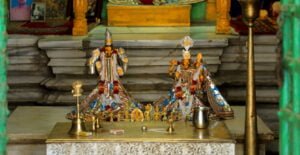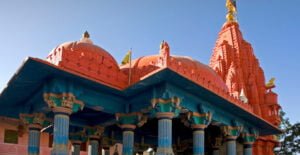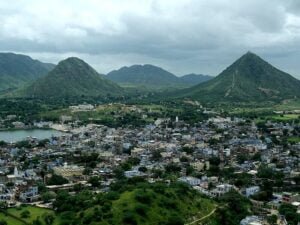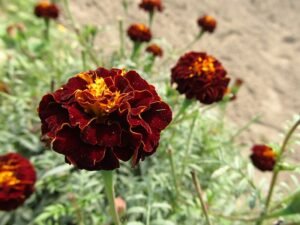No products in the cart.
PUSHKAR: A TRYST WITH ROSES AND MARIGOLDS
Rajasthan
Myth, mystique, and memory are intertwined in a beautiful synthesis to illustrate the birth of the tranquil Pushkar Lake, created by no less than the Hindu divinity, Lord Brahma, the Creator. The story of Pushkar gathers fresh importance with each retelling, as this serene spot is considered one of the five most important pilgrimage points for Hindus.
Three petals, it is said fell from the lotus (padma) in the hands of Lord Brahma, as he sought an appropriate spot to conduct the great Yagna to which he had also invited Lord Vishnu and Lord Shiva along with the other deities. Three lakes sprang from the spots where the lotus petals fell— these were Jyestha Pushkar, Madhya Pushkar, and Kanistha Pushkar. While Brahma himself was the patron deity of Jyeshtha Pushkar, Vishnu reigned over Madhya Pushkar and Shiva over Kanistha.
 The yagna was held at sunrise on the auspicious time of Karthik Nakshatra. According to Vedic astrologers, this Nakshatra signifies a necklace and thus it exhibits a great cosmic significance. Karthik Nakshatra is known for its dynamic and fiery energy, which brings a sense of purification, transformation, and illumination. The yagna culminated on Purnima, the full moon night of the Hindu lunar month of Karthik.
The yagna was held at sunrise on the auspicious time of Karthik Nakshatra. According to Vedic astrologers, this Nakshatra signifies a necklace and thus it exhibits a great cosmic significance. Karthik Nakshatra is known for its dynamic and fiery energy, which brings a sense of purification, transformation, and illumination. The yagna culminated on Purnima, the full moon night of the Hindu lunar month of Karthik.
When the yagna came to an end Brahma directed devotees to do the parikrama of all three sacred lakes. As stated in the Padma Purana: “Just as there is no body of water like the ocean, there is no pilgrimage like Pushkar.” Pushkar is venerated as the king of all pilgrimages for Hindus; it is also known as Brahma Tirtha.
After a ritual dip in the sacred waters of Pushkar Lake, believed to have healing properties, devotees also pay obeisance at the Brahma Temple straddling the shoreline of the lake with its cavalcade of numerous shrines and 52 holy ghats.
Pushkar or Padmavati, as it is also known, lies 14km away from Ajmer famed for its 12th-century Khwaja Gharib Nawaz Dargah Sharif which immortalises the presence of the Sufi saint Moinuddin Chishti in this sacred city for the Muslim community
Though Pushkar’s spiritual beginnings link it to Lord Brahma, archaeological finds here trace its temporal antiquity to as far back as the 2nd century BCE revealing secrets of its trading days illuminated by coinage from its links with the Romans, Greeks, and Scythians. Pushkar’s fortunes have been steered by rulers such as Chauhans who were based in Sambhar, and the Mughals who were frequent visitors to the Dargah at Ajmer, which also came under their rule.
Rose Walk
 Devotees come baring floral tributes of roses and marigolds for Lord Brahma. The lotus, so deeply intertwined with the Pushkar legend, is a sacred flower as it holds special meaning in Hinduism and Buddhism, being symbolic of purity, enlightenment, and rebirth. Till the early 20th century lotus blooms, largely whites, were found aplenty at Pushkar—then poof …. they vanished with overkill by vendors.
Devotees come baring floral tributes of roses and marigolds for Lord Brahma. The lotus, so deeply intertwined with the Pushkar legend, is a sacred flower as it holds special meaning in Hinduism and Buddhism, being symbolic of purity, enlightenment, and rebirth. Till the early 20th century lotus blooms, largely whites, were found aplenty at Pushkar—then poof …. they vanished with overkill by vendors.
Now it’s roses, roses all the way radiating away from the lake, to the city outskirts carpeted with rose farms in villages like Bhawata, Amba, Motisar, Bhagwanpura, Ganheda, Kishanpura, Devnagar and Kanas, Nadi 1 and Nadi II; rose cultivation in Pushkar, pre-pandemic employed around 7,000 farmers. Marigold flowers are also cultivated here. Primary domestic clients are the temples of Pushkar and the Dargah at Ajmer.
Pushkar has a lively rose trade, of both fresh flowers and dried rose petals, with international markets such as the Middle East. As the flowers are delicate and considered perishable commodities, they are packed in jute. In Gujarat, Surat and Kandwa are major buyers of dried rose petals from Pushkar.
Not many travellers are conversant with Pushkar’s delightful floricultural traditions. Mughal Jehangir, famed also for his passionate botanical interests, is said to have visited the rose nurseries in the area on his visits to the Dargah at Ajmer. Visitors can explore Ajmer’s bazaars to pick up rose ittars, said to have been originally introduced by inspirations from Jehangir’s wife Nur Jehan who had a penchant for bathing in water perfumed and strewn with rose petals.
Pushkar’s association with roses was further strengthened with the Mughals encouraging cultivation to meet their needs for ittars, sherbets, wines, and personal care products. They even established perfumers, gandhis or ‘itr-saaz, going as far as sanctioning them Zamindaries and allowing them the freedom to experiment making new varieties of ittars for these luxury items which became a big trend in the Mughal court. As reflected by excerpts from Emperor Akbar’s chronicler Abul Fazl ‘s Ain-i Akbari, ittars made of rosewater and musk were sold by the bottle for Rs1-3. Akbar even had a dedicated department of perfumery.
 The intoxicating scent of roses assails your senses as you set off on a round of the rose farms at Pushkar. This incredible journey offers a fantastic experience in which travellers will encounter many different varieties. One of the most popular was the damask rose. The damask rose (Rosa ×damascena) blooms are the source of attar of roses used in perfumes. About five tons of petals, or 3 to 4 million flowers, are needed to obtain on average 1 kg of Damask rose essential oil. This low yield explains the rarity and high price of this essential oil. Many species, particularly the rugosa rose (R. rugosa), produce edible rose hips, which are a rich source of vitamin C and are sometimes used in preserves.
The intoxicating scent of roses assails your senses as you set off on a round of the rose farms at Pushkar. This incredible journey offers a fantastic experience in which travellers will encounter many different varieties. One of the most popular was the damask rose. The damask rose (Rosa ×damascena) blooms are the source of attar of roses used in perfumes. About five tons of petals, or 3 to 4 million flowers, are needed to obtain on average 1 kg of Damask rose essential oil. This low yield explains the rarity and high price of this essential oil. Many species, particularly the rugosa rose (R. rugosa), produce edible rose hips, which are a rich source of vitamin C and are sometimes used in preserves.
A tour of the rose farms will also introduce you to the finer points of traditional processes for making rose water, ittars as well as products like gulkund. It’s interesting to note that unlike in Western scents where alcohol is preferred as a base, Indian attars are usually distilled using an oil base, with sandalwood oil being pre-eminent.
Pushkar roses are today extensively used in aromatherapy traditions, serums, skincare products, massage oils, joss sticks, room fresheners and diffusers etc.
In Pushkar bazaar you can buy rose water, rose oil, and gulkund (a combination of roses, honey, and sugar) used in sweetening paans that are so popular as digestives with the locals. Check out Kamal & Company across from Gau Ghat, which sells rose products such as rosewater, joss sticks, perfumes, and gulkund.
Traditional Heritage Walk in Pushkar |
To do a deep dive into Pushkar’s religious and cultural offerings hire a knowledgeable local guide who will provide deeper insights into this sacred lake city. The starry highlights on this tour are the ancient Brahma Temple, Mukhya Brahma Ghat, Bade Ganesha Ji Ka Mandir, Gyan Gopal Ji Ka Mandir, Shahi Mosque, Malpua Gali, Ram Laxman Temple, Old Rangji Temple, Varaha Temple, New Rang Ji Temple, Bihari Ji Ka Temple. End the day at the serene setting of Jaipur Ghat in the southeastern reaches of the lake and soak in the glowing colours of the setting sun. The evening aarti is also worthy of spending moments in contemplation at this tranquil pilgrimage hub, which was acquainted with many ancient seers who came here to meditate centuries ago. |
















